Blog: A quick look at: women and the economy
- Business Advice
- Talent and Skills
- 10 Min Read
On 4 March 2022 the House of Commons published a report examining women’s participation in business across the UK called Women and the economy.
It looks at trends in employment, women’s earnings, and explores the role women play in leading UK businesses.
Ahead of International Women’s Day, let’s look at some of the most interesting findings and see whether inequality in the workplace has improved at all in the last decade.
Women in employment
There’s still a gender pay gap
Although it’s been gradually decreasing since 1997, there is still a very evident gender pay gap.
As of April 2020, that gap – in median hourly pay for men and women – was 7.9% for full-time employees, and 15.4% for all employees.
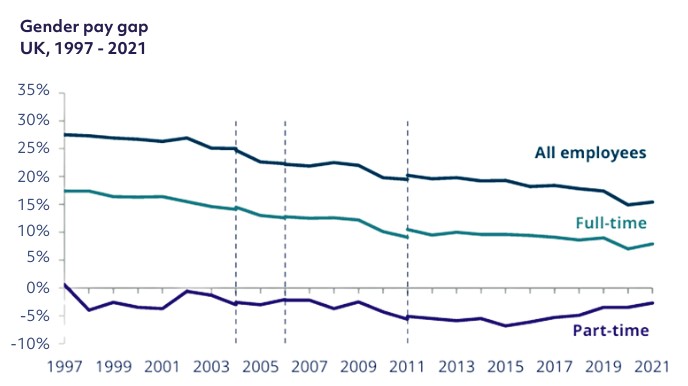
Source: ONS, Annual Survey of Hours and Earnings, 2021
The 15.4% statistic comes from the ONS Annual Survey of Hours and Earnings as per the chart above, but large employers are also required to report gender pay gap information. When we look at that, across all employers who reported, the gap is 12.8%, also based on median hourly pay.
So either way, there is clearly still some work to be done to bring female pay in line.
Well-paid for part-time
Where the pay gap flips, is in part-time employment; women get paid 2.7% more than men in part-time positions. According to recent ONS statistics, 38% of all part-time employment was held by women compared to 13% of men.
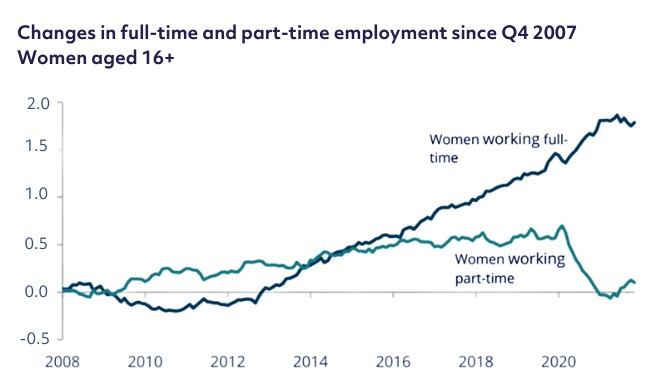
Source: ONS, Labour Market bulletin, Table EMP01, 15 February 2022
It’s thought the positive part-time pay gap could be down to highly educated and experienced professionals choosing to reduce their hours after they’ve started a family, resulting in more qualified women taking part-time hours and, as a result, demanding higher compensation.
This theory is supported if you look at how the gender pay gap differs between age groups.
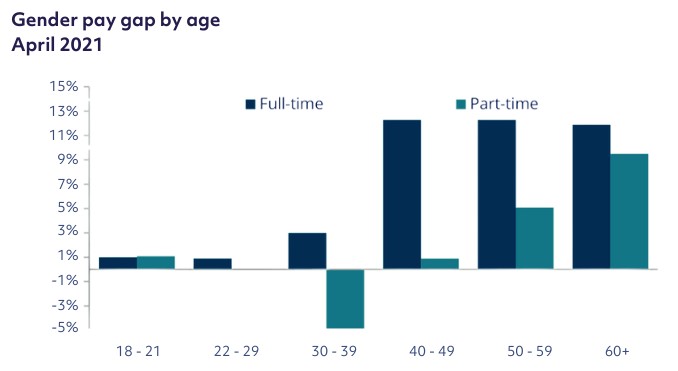
Source: ONS, Annual Survey of Hours and Earnings, 2021
While the gap is relatively small for employees in their 20s and 30s, it widens considerably for employees in their 40s when major life changes often occur.
Time spent out of the labour market is one explanation, but other differences like educational attainment in younger generations propelling employment in higher-paying industries or occupations should also be considered.
Women in business
Women are still much more likely than men to work as employees (90% of women vs 84% of men), although the number of women identifying as self-employed has continued to increase since the financial crash in 2008 (self-employment figures for both genders fell over the pandemic).
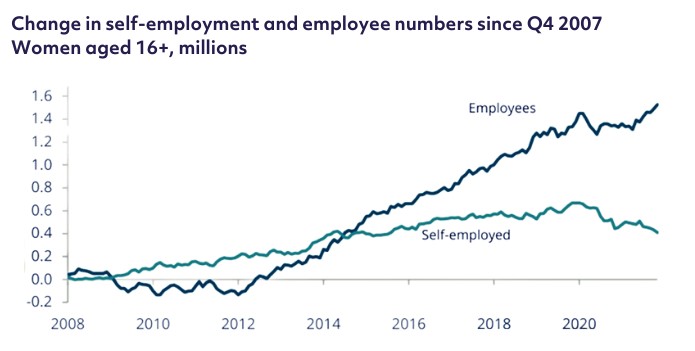
Source: ONS, Labour Market bulletin, Table EMP01, 15 February 2022
Female-led SMEs
It’s estimated that women-led SMEs contribute around £85bn to UK economic output every year, but the number of SME employers led by women in 2020 was still relatively small at just 16% (that is SME employers either led by one woman, or by a management team that is majority female). Female-owned or led SMEs with no employees was slightly higher, at 21% in 2020.
These statistics, though, are not significantly growing year on year, and there is still work to be done particularly in attracting women to ‘total early-state entrepreneurial activity’ – or, start-ups.
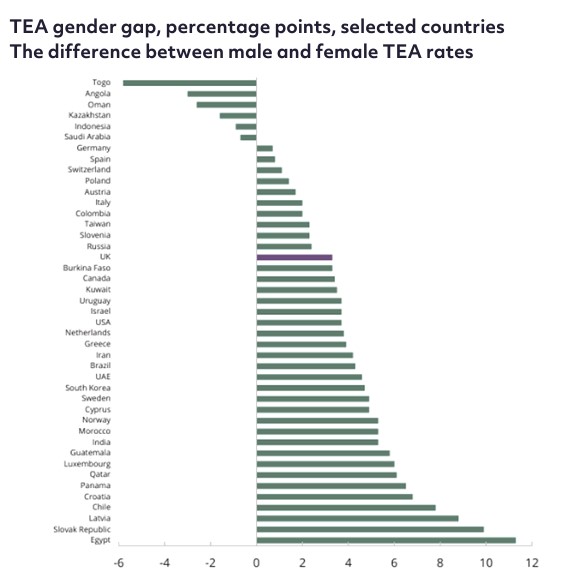
Global Entrepreneurship Monitor, 2020/21 Global Report, 2021
In 2020/21, the TEA rate in the UK (the proportion of working-aged people involved in TEA) was 9.5% for men, and 6.2% for women. This means that the TEA gap (the difference between the male and female rates) was 3.3 percentage points in the UK.
The chart above compares TEA gap points in countries covered by the Global Entrepreneurship Monitoring Consortium study.
Germany, Spain, Italy, and Poland all rank above the UK for women participating in start-up activity, with Saudi Arabia, Indonesia, Kazakhstan, Oman, Angola, and Togo all showing a higher proportion of women being involved in start-ups than the proportion of men.
Female business hit by Covid-19
As well as low representation in the start-up sector, women who do lead UK SMEs also tend to do so in sectors that were vulnerable to the effects of the Covid-19 pandemic.
Examining only SMEs with employees, women-led businesses were most likely to be in the health (37%), education (36%), accommodation and food services, and other services sectors (both 25%). “Other services” includes businesses such as sports facilities, funeral homes, hairdressers, and businesses offering beauty treatments.
Many of these sectors were the most severely impacted by restrictions introduced to combat the spread of Covid-19.
While these businesses will most likely have received a variety of local authority and national scheme financial support during the pandemic, there is evidence to suggest that female-led businesses may have struggled to source the same support as male-led ones.
The British Business Bank reported that just 1% of Future Fund loan funding went to firms with all-female teams, vs 19% to firms with all-male management.
As the Future Fund provided convertible loans to UK start-ups and considering the lack of female activity in the start-up space, this isn’t surprising but is still disproportionate.
Future Fund: management team diversity. 30 June 2021 |
|||
| Gender | Number of loans | Total loan value £m | % Total value |
| Mixed gender | 811 | 850.2 | 75% |
| All-male | 314 | 219.1 | 19% |
| All-female | 16 | 15.1 | 1% |
| Not disclosed | 49 | 52.2 | 50% |
Researchers from Kings College London published a report in September 2020 that discussed the challenges for entrepreneurs during Covid-19 (PDF), including gender impacts.19 The report concluded there were many areas where female and male entrepreneurs’ experiences did not differ but, “on balance, the Covid-19 pandemic impacted women entrepreneurs more adversely than men entrepreneurs.”
More to do
Celebrated on 8 March 2022, International Women’s Day showcases women’s achievements but also raises awareness against bias.
Looking at pay equality and female leadership is one way we can assess how far we’ve come in achieving female equality in the workplace but there is so much more to be done.
The International Women’s Day website has some excellent resources for companies trying to develop inclusive work cultures where women’s careers thrive, and we would encourage everyone to check them out.
Already doing something great? We want to hear your stories of women breaking down barriers, achieving big, and thriving in your sector. Share them with us on LinkedIn or Twitter and we’ll celebrate with you.

